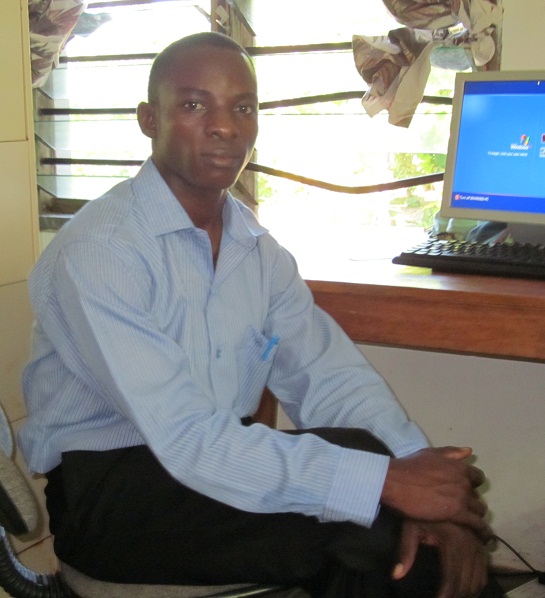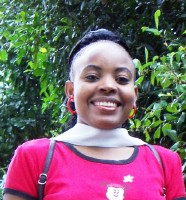Today I’d like to introduce the two main players in the ASSETS team: Festus and Bimbo. Both have been employed recently at A Rocha Kenya under the ASSETS program, and have not been introduced yet on this blog.
 Both have been very busy, as they have had to distribute bursaries to all of the schools supported by ASSETS in the last few weeks. So while we had time for Bimbo to write about what brought him to work for A Rocha, Festus had to answer questions quickly for me to write up before he headed out today!
Both have been very busy, as they have had to distribute bursaries to all of the schools supported by ASSETS in the last few weeks. So while we had time for Bimbo to write about what brought him to work for A Rocha, Festus had to answer questions quickly for me to write up before he headed out today!
Festus Masha – Community Conservation Officer
Festus started work at A Rocha in December 2010, as the new Community Conservation Officer. Prior to being employed by A Rocha, he had spent five years working for Kenya Medical Research Institute as a Field Officer, and completed a diploma in Community Development and Project Management.
When I asked why working in the ASSETS program interested him, Festus responded that he likes the community interaction aspect of the program: holding meetings with the needy families and the distribution of bursaries. He is concerned for the welfare of the families, and feels it is very important to help his community
 Bimbo Msafiri Baya – Assistant Community Conservation Officer
Bimbo Msafiri Baya – Assistant Community Conservation Officer
I joined Marafa Secondary School in the year 2002-2005. Later I joined Pwani University and completed my course in the year 2010. At Pwani I pursued a certificate course in Community Development. Before I left Pwani, I obtained an advert for A Rocha seeking for employees.
After having sent my application, I was called for an interview, in which I was successful. I started working as an A Rocha employee on 4th May 2011. My job title is the Assistant Community Conservation Officer. As a new employee I have been doing data entry of the beneficiary information. Also I have joined the other Assets staff and volunteers in starting a farm at Gede, where we are piloting Farming God’s Way (a Christian conservation agriculture program).
So far I have enjoyed working as an employee at A Rocha because the focus on the conservation of the environment is an interesting one. Also, assisting the less fortunate families enhances the local community, and also brings joy to the beneficiaries.
I am glad to work here, I am hoping that I will continue to gain more experience in environmental conservation at A Rocha.







 My names are Tony Kanundu alias Bats; I work for ASSETS as a Community Conservation Officer. I grew up at Gede 500m from the edge of the Arabuko-Sokoke Forest. I am named Kanundu after my grandfather who was really a character of his kind. Locally, the name has two meanings. In Swahili language, Kanundu is a small hump of any animal and in Giriama, my first language, Kanundu is a bat; the flying mammal. Guess which character I am! My grandfathers’ characters resembled those of a bat but he could neither fly nor was he nocturnal. He was known to be tricky and a strategist and he could do things many people didn’t believe. He could disperse a crowd helter-skelter with his own intention, the same way Drogba can cut through a solid defense call it of any soccer team. When I was taught about mammals in high school, I was very amazed to learn the real character of the real flying mammal. As my grandpa could do, a bat which is nocturnal moves in a very marvelous way, without eyes it uses echo-location. As it flies lazily, it sends rays ahead and if there are any obstacles, the rays are reflected back to it and the Bat changes its route and it is able to enjoy its world in the night. As I grew at age 14 I joined a local football club, Clarkes Weaver which was supported by Kenya Wildlife Service, Gede Forest station. The playing field was right in the forest and this was an opportunity to see wild animals. Apart from playing football I was voluntarily involved in small forest conservation activities. During and after high school I was very active member of the football club and later through my local church I joined A Rocha Kenya as a volunteer in the ASSETS programme. After 14 months volunteering, I had significant know how on the environment and the community around and the need for its involvement in conservation of the natural resources. This was a good time for me to move on. I stopped volunteering and joined Kenya Wildlife Service Training Institute where I studied Environmental Management for 2 years. Early January 2007, a few weeks before I graduated, I was called up by the ASSETS Co-ordinator to take up this job in the Community project. Ever since, I am enjoying working with the communities for the environment from the environment.
My names are Tony Kanundu alias Bats; I work for ASSETS as a Community Conservation Officer. I grew up at Gede 500m from the edge of the Arabuko-Sokoke Forest. I am named Kanundu after my grandfather who was really a character of his kind. Locally, the name has two meanings. In Swahili language, Kanundu is a small hump of any animal and in Giriama, my first language, Kanundu is a bat; the flying mammal. Guess which character I am! My grandfathers’ characters resembled those of a bat but he could neither fly nor was he nocturnal. He was known to be tricky and a strategist and he could do things many people didn’t believe. He could disperse a crowd helter-skelter with his own intention, the same way Drogba can cut through a solid defense call it of any soccer team. When I was taught about mammals in high school, I was very amazed to learn the real character of the real flying mammal. As my grandpa could do, a bat which is nocturnal moves in a very marvelous way, without eyes it uses echo-location. As it flies lazily, it sends rays ahead and if there are any obstacles, the rays are reflected back to it and the Bat changes its route and it is able to enjoy its world in the night. As I grew at age 14 I joined a local football club, Clarkes Weaver which was supported by Kenya Wildlife Service, Gede Forest station. The playing field was right in the forest and this was an opportunity to see wild animals. Apart from playing football I was voluntarily involved in small forest conservation activities. During and after high school I was very active member of the football club and later through my local church I joined A Rocha Kenya as a volunteer in the ASSETS programme. After 14 months volunteering, I had significant know how on the environment and the community around and the need for its involvement in conservation of the natural resources. This was a good time for me to move on. I stopped volunteering and joined Kenya Wildlife Service Training Institute where I studied Environmental Management for 2 years. Early January 2007, a few weeks before I graduated, I was called up by the ASSETS Co-ordinator to take up this job in the Community project. Ever since, I am enjoying working with the communities for the environment from the environment.


